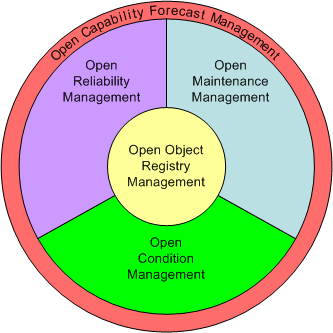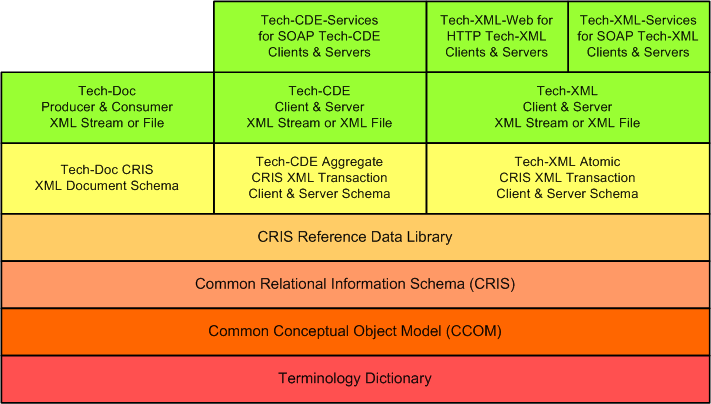Open System Architecture for Enterprise Application Integration
What is OSA-EAI?
The OSA-EAI specification provides (1) an information exchange standard to allow sharing asset registry, condition, maintenance and reliability information between enterprise systems and (2) a relational database model to allow storage of the same asset information. The OSA-EAI uses a layered architecture to allow individual components to be used independently to satisfy functional requirements.

To accommodate various types of applications and integration scenarios, the OSA-EAI supports the exchange of XML files over multiple data transport options including files (Tech-Doc), HTTP (Tech-XML-Web), and SOAP Web Services (Tech-XML-Services). The Web Service definitions are sufficiently granular such that they can be used in a Service-Oriented Architecture (SOA).

The relational database model (CRIS) is represented as a logical and physical model, with SQL scripts targeted for Oracle Database and Microsoft SQL Server. The SQL scripts include both creating the database schema and inserting the MIMOSA Reference Data, the latter which can be extended to support unique project or organizational requirements. Tech-CDE-Services provides an efficient mechanism to manage a CRIS database via Web Services.
Why was it developed?
Operators, maintenance personnel, logistic managers, OEMs, parts suppliers, and engineers have always wanted to have information about the condition of equipment assets at their fingertips when they need it. Unfortunately, it typically is scattered among separate information systems, one for each platform and then separated by information type: manufacturers nameplate data, as-installed data, as-maintained data, operational data, condition monitoring data (such as vibration readings, infrared thermography, oil analysis, control device monitoring, etc.), and asset diagnostic/health and reliability data.
It is difficult, if not impossible, to view the different information types on the same computer terminal, let alone compile and synchronize them into an integrated view or report on which to base intelligent asset management decisions. Even when the systems can be accessed from the same display, it usually requires customized efforts to integrate disparate databases which use proprietary programs with different data models.
Interconnectivity of the islands of engineering, maintenance, operations, and reliability information is envisioned by use of the OSA-EAI. Previously, these separate information islands were built using specialized proprietary systems that provided value because they were optimized for a specific task or tasks, and they provided best results and value for those purposes. However, their combined value can be multiplied significantly if they can be merged into an information “data network”. The “data network” can be realized by building open OSA-EAI bridges to proprietary data stores to allow this information to be easily understood and utilized.
Building custom bridges
In the past, communication between data sources was constructing by developing software bridges between all the disparate data systems. This normally contracting to an integration company or utilizing in-house information resources.
Advantages include:
- High level of customization for commercial and military needs
- High performance tuned to specific bandwidth requirements
Limitations include:
- High risk due to unforeseen incompatibility issues
- High cost due to lack of multiple users
- Difficulty in resolving problems among application suppliers (possible pointing)
- Possible dependence on proprietary interfaces
- High annual software maintenance cost. These costs typically run around percent of original cost which translates to $100,000 annual costs for a $500,000 software integration project.
Using an open EAI systems bridge
A number of the limitations inherent in custom bridge solutions can be overcome by using an open Enterprise Application Integration (EAI) specification. In mature sectors, this translates into plug-and-play capability that allows a company’s information services department to hook up any compliant product to the network.
Advantages include:
- Engineered plug-and-play system capability designed up-front into system
- No burden of on-going integration efforts
- More freedom to choose best technology from information supplier (plug and play)
- Creation of the information backbone of e-maintenance
Limitations include:
- Necessity for suppliers to support industry standard
- Standard gateway may exhibit some performance degradation when custom interface is supplied
What are the benefits?
The OSA-EAI offers advantages for maintenance and reliability users as well as technology developers and suppliers. For users, the adoption of MIMOSA OSA-EAI facilitates the integration of asset management information, provides a freedom to choose from a broader selection of software applications, and saves money by reducing integration and software maintenance costs.
For technology suppliers, the adoption of MIMOSA OSA-EAI stimulates and broadens the market, allows concentration of resources on core high-value activity rather than low value platform and custom interface requirements, and provides an overall reduction in development costs.
Taken as a whole, maintenance and reliability information is complex. A Collaborative Maintenance network must provide for the open exchange of equipment asset related information between condition assessment, logistic, and maintenance information systems. The condition assessment sector must include the specialized data required by vibration, oil analysis, infrared thermography, motor circuit evaluation, and many other technologies.
Prior to MIMOSA, developers defined data fields to fit their own hardware and software systems. MIMOSA’s experts from across the globe have spent more than 10 years in developing the OSA-EAI so that all loosely-coupled systems can exchange information by using MIMOSA’s open system architecture.
Releases
The MIMOSA OSA-EAI is released under the MIMOSA License Agreement.
| Title | Release Date | Version | Download |
|---|---|---|---|
| OSA-EAI 3.2.3a | May 12, 2014 | 3.2.3a | |
| OSA-EAI 3.2.3 | July 1, 2013 | 3.2.3 | |
| OSA-EAI 3.2.2 | December 31, 2009 | 3.2.2 | |
| OSA-EAI 3.2.1 | December 31, 2008 | 3.2.1 | |
| OSA-EAI 3.2.0 | December 31, 2007 | 3.2.0 | |
| OSA-EAI 3.1.1 | July 9, 2007 | 3.1.1 | |
| OSA-EAI 3.1 | December 30, 2006 | 3.1 | |
| OSA-EAI 3.0h | May 2, 2006 | 3.0h | |
| OSA-EAI 2.2e | August 13, 2003 | 2.2e | |
| OSA-EAI 2.2 | May 5, 2003 | 2.2 | |
| OSA-EAI 2.1 | May 23, 2002 | 2.1 | |
| OSA-EAI 1.1 | June 19, 1998 | 1.1 |



